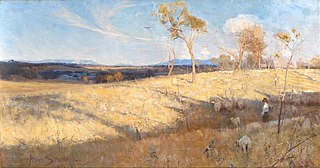
The Victorian Artists Society, which can trace its establishment to 1856 in Melbourne, promotes artistic education, art classes and gallery hire exhibition in Australia. It was formed in March 1888 when the Victorian Academy of Arts and the Australian Artists' Association amalgamated.

The Heidelberg School was an Australian art movement of the late 19th century. It has been described as Australian impressionism.

William Beckwith McInnes was an Australian portrait painter, winner of the Archibald Prize seven times for his traditional style paintings. He was acting-director at the National Gallery of Victoria and an instructor in its art school.

Frederick McCubbin was an Australian artist, art teacher and prominent member of the Heidelberg School art movement, also known as Australian impressionism.

Thomas William Roberts was an English-born Australian artist and a key member of the Heidelberg School art movement, also known as Australian impressionism.

Sir Arthur Ernest Streeton was an Australian landscape painter and a leading member of the Heidelberg School, also known as Australian Impressionism.

The Athenaeum or Melbourne Athenaeum at 188 Collins Street is an art and cultural hub in the central business district of Melbourne, Victoria, Australia. Founded in 1839, it is the city's oldest cultural institution.

The Ian Potter Centre: NGV Australia is an art gallery that houses the Australian part of the art collection of the National Gallery of Victoria (NGV).

The Box Hill artists' camp was a site in Box Hill, Victoria, Australia favoured by a group of plein air painters in the mid to late 1880s who later became associated with the Heidelberg School art movement, also known as Australian impressionism.

Clarice Marjoribanks Beckett was an Australian artist and a key member of the Australian tonalist movement. Known for her subtle, misty landscapes of Melbourne and its suburbs, Beckett developed a personal style that contributed to the development of modernism in Australia. Disregarded by the art establishment during her lifetime, and largely forgotten in the decades after her death, she is now considered one of Australia's greatest artists.

Walter Herbert Withers was an English-born Australian landscape artist and a member of the Heidelberg School of Australian impressionists.

The Geelong Art Gallery, currently known as Geelong Gallery, is a major regional gallery in the city of Geelong in Victoria, Australia. The gallery has over 6,000 works of art in its collection. The Gallery forms Geelong's Cultural Precinct with the adjacent Geelong Library and Heritage Centre, Geelong Arts Centre, and the Geelong Courthouse.

James Peter Quinn was an Australian portrait painter born in Melbourne.

On the wallaby track is a 1896 painting by the Australian artist Frederick McCubbin. The painting depicts an itinerant family; a woman with her child on her lap and a man boiling a billy for tea. The painting's name comes from the colloquial Australian term "On the wallaby track" used to describe itinerant rural workers or "swagmen" moving from place to place for work. The work has been described as "among the best known and most popularly admired of Australian paintings".

Polly Hurry, was an Australian painter. She was a founding member of the Australian Tonalist movement and part of the Twenty Melbourne Painters Society.

Estelle Mary (Jo) Sweatman (1872-1956), was an Australian painter. She was a founding member of the Twenty Melbourne Painters Society.

Henrietta Maria Gulliver was an Australian artist who specialized in landscape and floral still-life paintings. She was also a florist, horticulturalist and landscape designer.

May Vale (1862–1945), was an Australian painter. She was reportedly the first women to be elected a member of the Buonarotti Society.
Cristina Asquith Baker (1868–1960) was an Australian artist known for her paintings and lithographs. She studied with Frederick McCubbin, one of the key artists of the Australian impressionist Heidelberg school, but she was independent and did not tie herself to a single school of thought. She twice studied abroad, in Paris and London, gaining expertise in various other forms of artistic expression such as lithography and carpet-making.
Louis Frederick McCubbin, only ever known as "Louis McCubbin", was an Australian war artist, landscape painter and art gallery director.



















